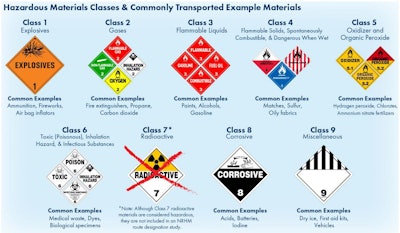A growing population in Austin, Texas now requires city officials there to come up with alternative routes for trucks carrying hazardous materials.
Since Austin’s population is now greater than 850,000, state law requires that a Non-Radioactive Hazardous Materials (NRHM) route be created for trucks carrying materials like explosives and flammable liquids (see NHRM chart below). As it stands now, trucks carrying such loads can travel throughout the city.
City officials are seeking input from citizens and trucking professionals on NRHM route planning. The first of three public forums took place in Austin Tuesday night at a local library, according to kvue.com.
Several trucking professionals who attended the two-hour meeting at the Ruiz Branch Public Library would like to see Interstate 35—a route popular with hazardous materials haulers and other truckers—included in NRHM mapping.
“For deliveries in Austin it (I-35) is much better because you can go straight to it, instead of going around and coming back in,” Larry Marshall of Mission Petroleum Carriers told kvue.com.
Marshall also said that State Highway 130, which runs parallel to I-35 about eight miles east of Austin, is not an ideal NRHM route. Though part of the highway features an 85mph speed limit—the fastest in the U.S.—it requires a toll that can add up fast for trucks that frequently travel there.
“The thing with 130, if you go from one end to the other, you’re looking at several dollars—$25 to $30—just to take a truck from one end to the other,” Marshall said.
The next public meeting is in January followed by the final meeting in June. Once completed, the city will send its route recommendations to the Texas Department of Transportation which is expected to approve of an NRHM route by fall 2017.
To learn more about Austin’s NRHM project, visit austintexas.gov/hazmat.











